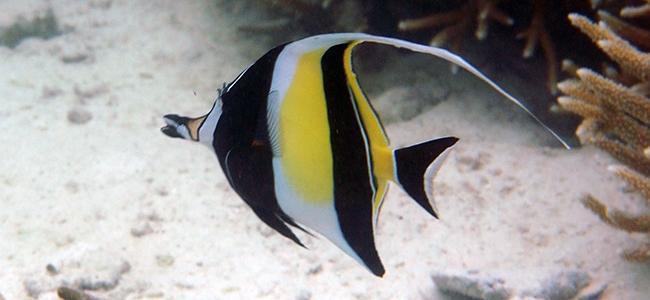The Zanclidae family is somewhat peculiar, since there is only one single species currently within this family, the Moorish Idol or scientifically known as Zanclus cornutus. It is a marine species that inhabits tropical and subtropical waters in coral reefs of the tropical Indo-Pacific, and has a disc-shaped body, very compressed laterally. Its jaw is tubular in shape with a small mouth at the end that allows them to search for food in crevices and hollows of the reef. One of its main characteristics is that the spines of the dorsal fin have elongated to form a whip-like filament. At the back of the eyes, it has corneal protuberances. Its coloration is white at the base with three vertical black stripes and a horizontal yellow spot at the origin of the snout and another yellow spot covering most of the body. The maximum size they can reach is 23 cm. It may resemble a kind of butterfly fish, the Heniochus acuminatus, but as soon as we stop to observe them, the differences are evident.
The Moorish Idol feeds mainly on sponges, but also eats small sessile invertebrates such as ascidians or some bryozoans. They are usually found in small groups of 2 to 3 individuals, and can be found in a range of depths between 3 and 182 meters.
The extinct species Eozanclus brevirostris is the closest species to Zanclus cornutus. It lived between 49 and 69 million years ago, in what is now the region of Monte Bolca in northern Italy where some fossils of relatively well-preserved specimens have been found. These fossils have allowed us to identify the major difference with Zanclus cornutus, and that is that Eozanclus brevirostris had a much shorter snout.
